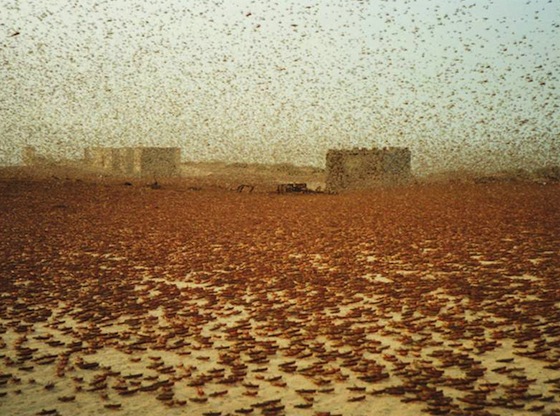Desert locusts traveling southwest from Algeria and Libya threaten to decimate crops in Niger and Mali, the Food and Agriculture Organization of the United Nations warned on Wednesday. Since rebel forces killed Gaddafi in October last year, insecurity along both sides of the Algerian-Libyan border has hampered pest control efforts, allowing locusts to swarm across the desert like a giant red blanket that obscures everything in sight. FAO officials predicted in March that if more was not done to control the migrating locusts, they would reach Niger in June. It seems they have arrived right on time.
Political insecurity hampers pest control
“How many locusts there are and how far they move will depend on two major factors – the effectiveness of current control efforts in Algeria and Libya and upcoming rainfall in the Sahel of West Africa,” said Keith Cressman, FAO Senior Locust Forecasting Officer.
First discovered in March in the southwestern corner of Libya, near Ghat, the locust swarms have been strengthened by May rains and increased vegetation in the Sahel.
Despite border trouble, both Algeria and Libya have been trying to stem the pests. Since May, Algeria has treated 40,000 hectares of land while Libya has treated about half that much. (It isn’t said how the locusts are controlled, but that might be a discussion for another time.)
“In a normal year, Algeria and Libya would have been able to control most of the local swarms and prevent their movement towards the south, but insecurity along both sides of the Algerian-Libyan border is getting in the way of full access by local teams and by FAO experts who need to assess the situation. Libya’s capacity to carry out control efforts has also been affected in the past year,” Cressman explained.
Uninterrupted disasters
This is not the first time that Niger has endured a locust plague. The last one, between 2003 and 2005, wiped out crops in 24 countries. FAO also worries that political instability in Mali could hinder pest control efforts in that country, which would be a open invitation for desert locusts to pay a destructive visit.
Meanwhile, in May Oxfam International reported that 18 million people living in the Sahel were without food after a sustained drought. Uninterrupted disasters in an already unforgiving environment are making life in the region virtually unlivable.
“The FAO Commission for Controlling the Desert Locust in the Western Region (CLCPRO) has provided $300 000 in funding to tackle locust infestations in Libya, according to a press release “and FAO has added an additional $400 000 to address the problem.”
Image via FAO
More on Drought, the Magreb and the Sahel:
A Clarion Call for Sahel Drought Victims
Gaddafi Dead: Will the Great Manmade River Follow?
Winterime Droughts Increase Due to Climate Change




